FRIDAY, SEPTEMBER 22
■ Tonight is equinox night. Fall begins in the Northern Hemisphere at 2:50 a.m. tonight EDT, 11:50 p.m. PDT. That's when the Sun (which we're facing away from at the time) crosses the equator heading south for the season. The days keep getting shorter.
■ Coincidentally, when summer turns to fall is about when Deneb takes over from brighter Vega as the zenith star shortly after nightfall (for skywatchers at mid-northern latitudes).
■ First-quarter Moon; exactly so at 3:32 p.m. EDT. After dark it's just over the spout of the Sagittarius Teapot, as shown below (for North American observers). If you're in the Pacific time zone, the Moon sets close to the time of the equinox.
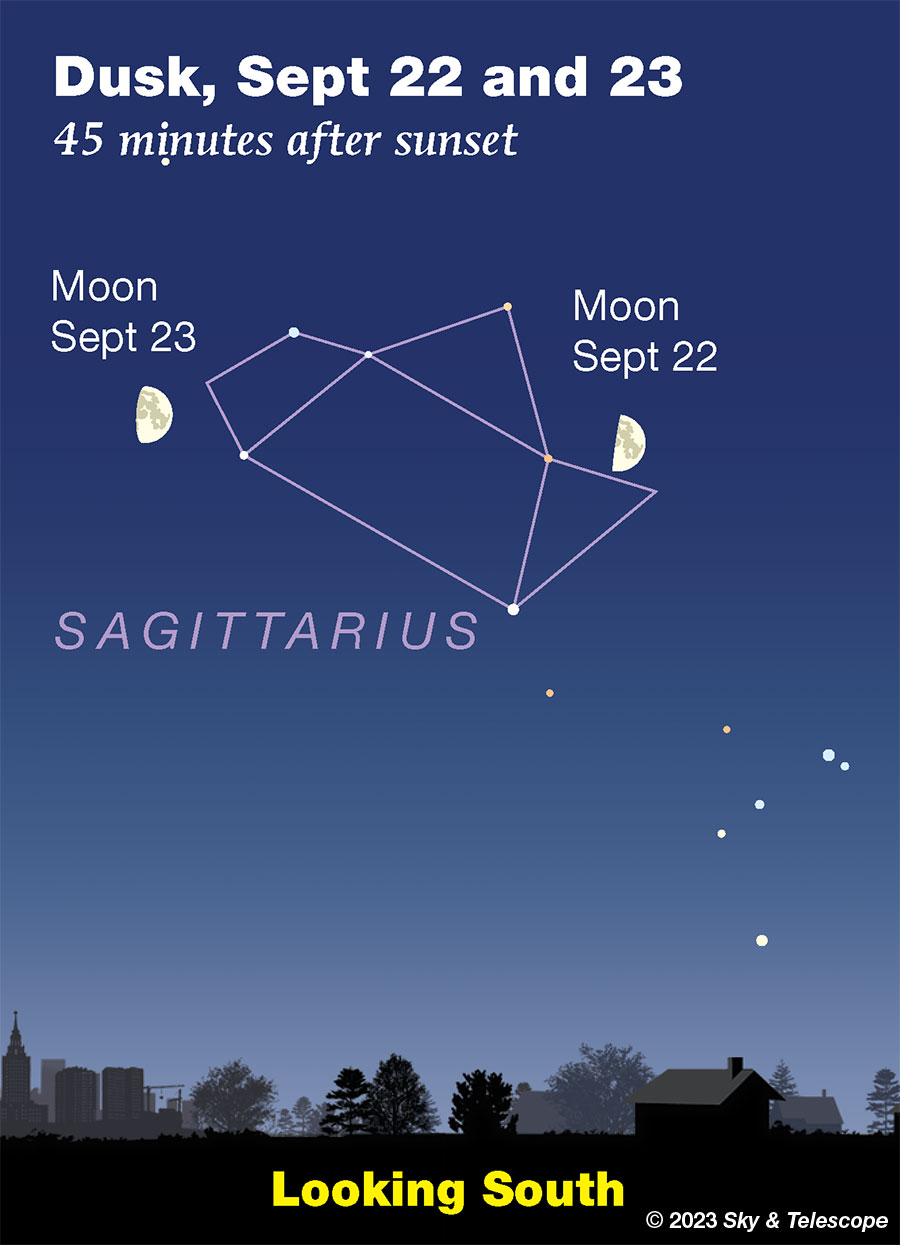
SATURDAY, SEPTEMBER 23
■ Now the Moon shines by the Teapot's handle, as shown above.
SUNDAY, SEPTEMBER 24
■ High above the Moon this evening, by 3 or 4 fists at arm's length, shines Altair, the southernmost star of the Summer Triangle. The other two, Vega and lesser Deneb, are nearly overhead.
MONDAY, SEPTEMBER 25
■ By 10 or 11 p.m. bright Jupiter is high and shines precisely east. (The exact time of that depends on your location.)
Look lower left of Jupiter, by about 1½ fists at arm's length, for the Pleiades.
A similar distance below the Pleiades, Aldebaran has risen or soon will.
Nearly three fists left of the Pleiades shines Capella, second in brightness to Jupiter.
TUESDAY, SEPTEMBER 26
■ Look a little upper left of the Moon early this evening for Saturn, as shown below. By mid- to late evening Saturn stands straight above the Moon.
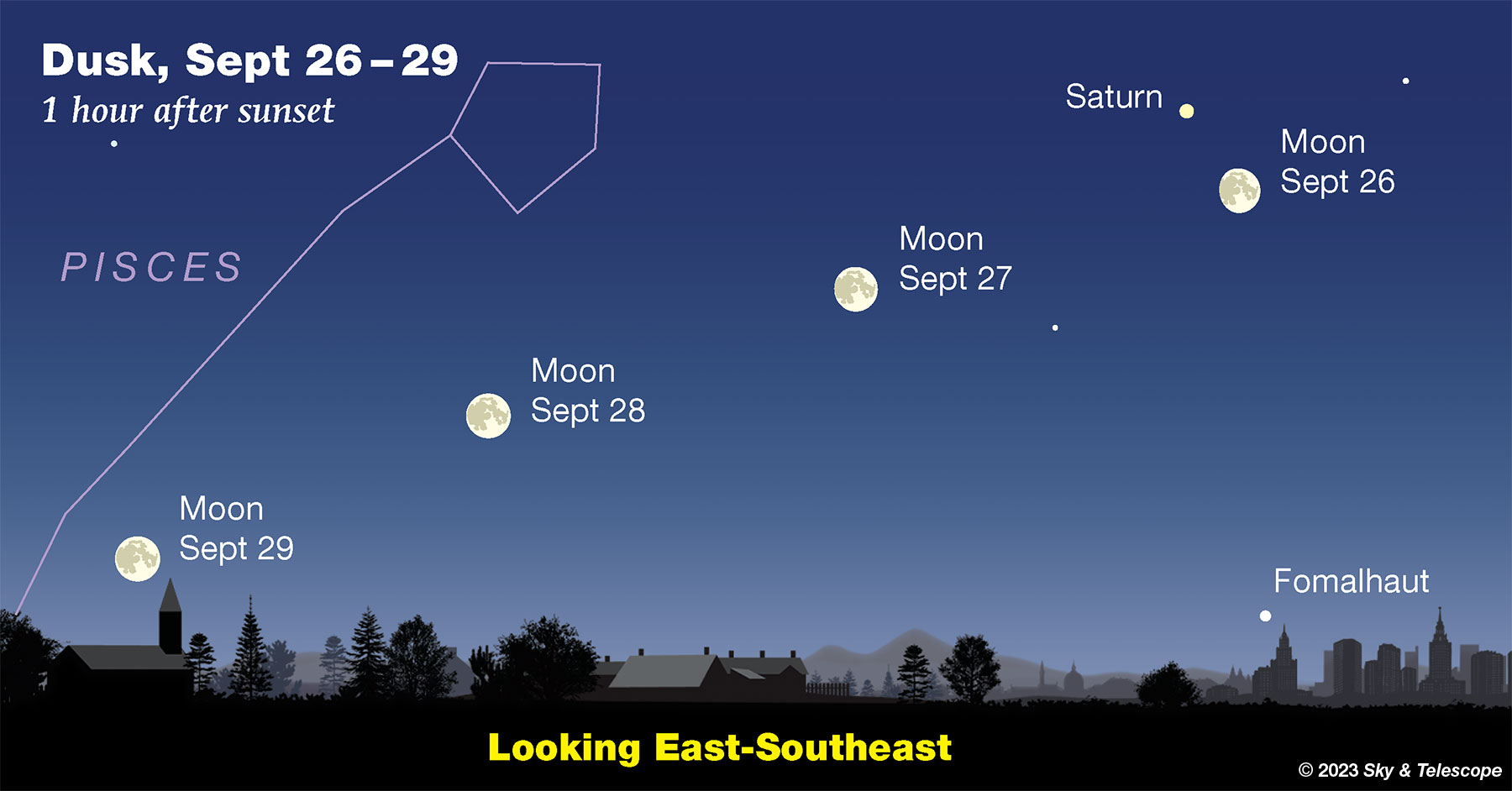
WEDNESDAY, SEPTEMBER 27
■ This is the time of year when, by mid-evening, the dim Little Dipper in the north "dumps water" into the bowl of the Big Dipper way down below. The Big Dipper will dump it back in the evenings of spring.
THURSDAY, SEPTEMBER 28
■ Full Moon tonight and tomorrow. It's exactly full at 5:58 a.m. Friday morning EDT, between those two evenings. This is a "supermoon," slightly closer and larger than the average full Moon, because the Moon is near perigee. But you'll have to be a careful and dedicated Moon watcher to detect the small difference.
■ Arcturus shines in the west as twilight fades away. Capella, equally bright, is barely rising in the north-northeast (depending on your latitude; the farther north you are the higher it will be.) They're both magnitude 0.
Later in the evening, around 9 p.m., Arcturus and Capella shine at the same height. When will this happen? That depends on both your latitude and longitude.
When it does, turn around and look low in the south-southeast, far lower right of the bright Moon. There will be 1st-magnitude Fomalhaut at about the same height too — exactly so if you're at latitude 43° north (Boston, Buffalo, Milwaukee, Boise, Eugene). Seen from south of that latitude, Fomalhaut will appear higher than Capella and Arcturus are. Seen from north of there, it will be lower.
That bright light more than a third of the way from Capella to Fomalhaut is Jupiter.
Higher above Fomalhaut is Saturn, glowing steadily with a pale yellowish tint.
FRIDAY, SEPTEMBER 29
■ Even as the stars come out in late twilight, Cassiopeia is already higher in the northeast than the sinking Big Dipper is in the northwest. Later in the evening, Cassiopeia's broad W pattern wheels higher and stands on end (its fainter end).
■ Also in early evening, look above the bright Moon to see if you can make out the Great Square of Pegasus through the moonlight. It's balancing on one corner, making it the Great Diamond of Pegasus? The line from its top corner through its bottom corner points down at the Moon.
SATURDAY, SEPTEMBER 30
■ Vega is the brightest star very high in the west after nightfall. Arcturus, equally bright, is getting low in the west-northwest.
The brightest star in the vast expanse between them, about a third of the way from Vega down toward Arcturus, is Alphecca, magnitude 2.2 — the crown jewel of Corona Borealis. Alphecca is a 17-day eclipsing binary, but its brightness dips are too slight for the eye to see reliably.
SUNDAY, OCTOBER 1
■ Cygnus the Swan floats nearly straight overhead these evenings. Its brightest stars form the big Northern Cross. When you face southwest and crane your head up, the cross appears to stand upright. It's about two fists at arm's length tall, with Deneb as its top. Or to put it another way, when you face that direction the Swan appears to be diving straight down. Migrating away for fall?
This Week's Planet Roundup
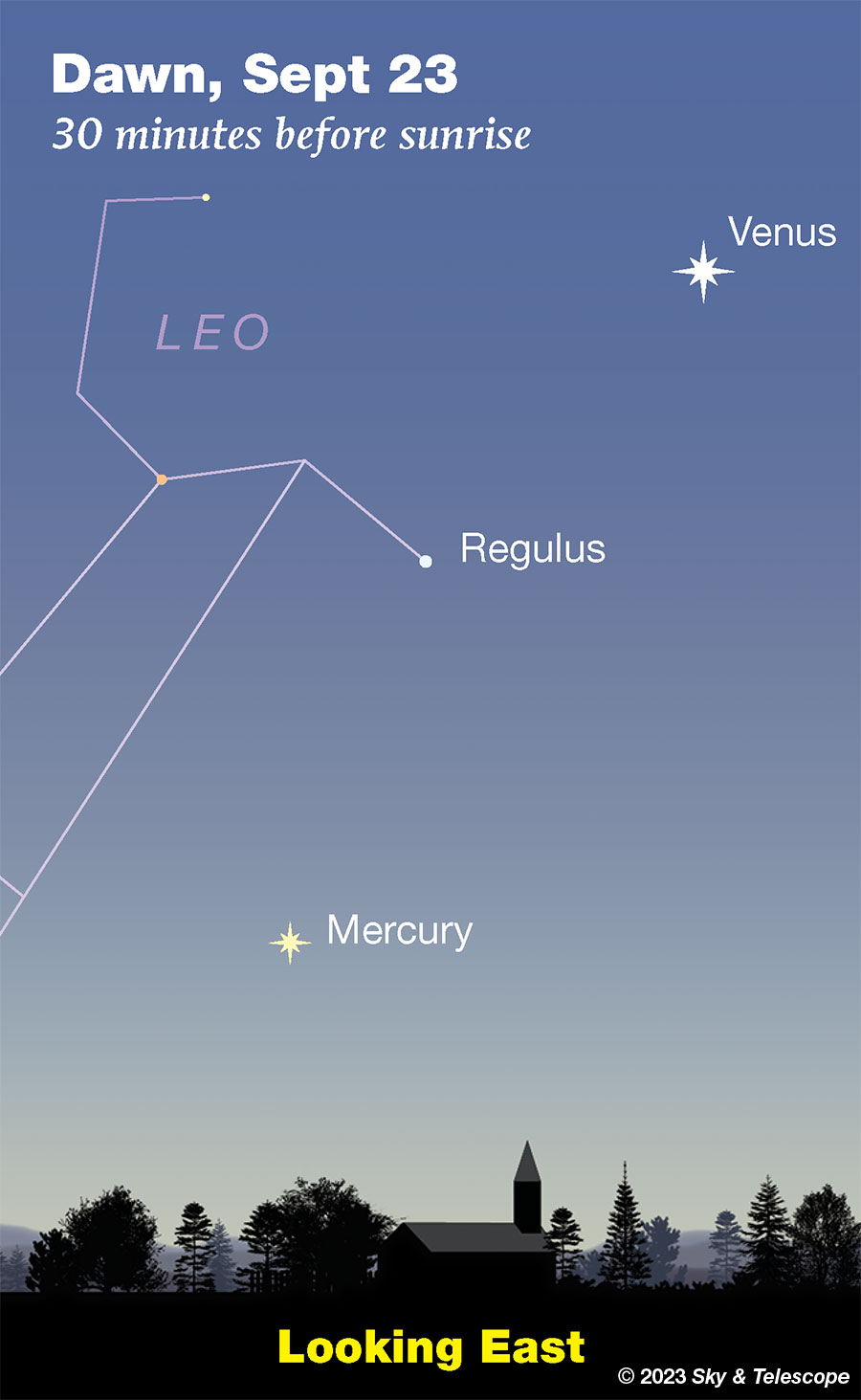
Mercury stands out nicely now low in the east in early dawn. Look for it far to the lower left of bright Venus, as shown above. They're about 2½ or 3 fists at arm's length apart. Mercury is brightening, from magnitude –0.5 on the morning of the 23rd to a showy –1.0 by the 30th.
Venus (a brilliant magnitude –4.7, in dim Cancer) is now about as high as its going to get as the "Morning Star." Look east before and during dawn. It rises more than two hours before dawn's first light — a weird UFO on the horizon, far under Castor and Pollux. In a telescope Venus is a thick crescent: 1/3 sunlit.
Mars is out of sight behind the glare of the Sun and will remain so for the rest of the year.
Jupiter (magnitude –2.8) rises in the east-northeast around the end of twilight. Watch for it to come up under the brightest stars of Aries. Jupiter dominates the eastern sky through late evening and shines highest in the south during the early-morning hours.
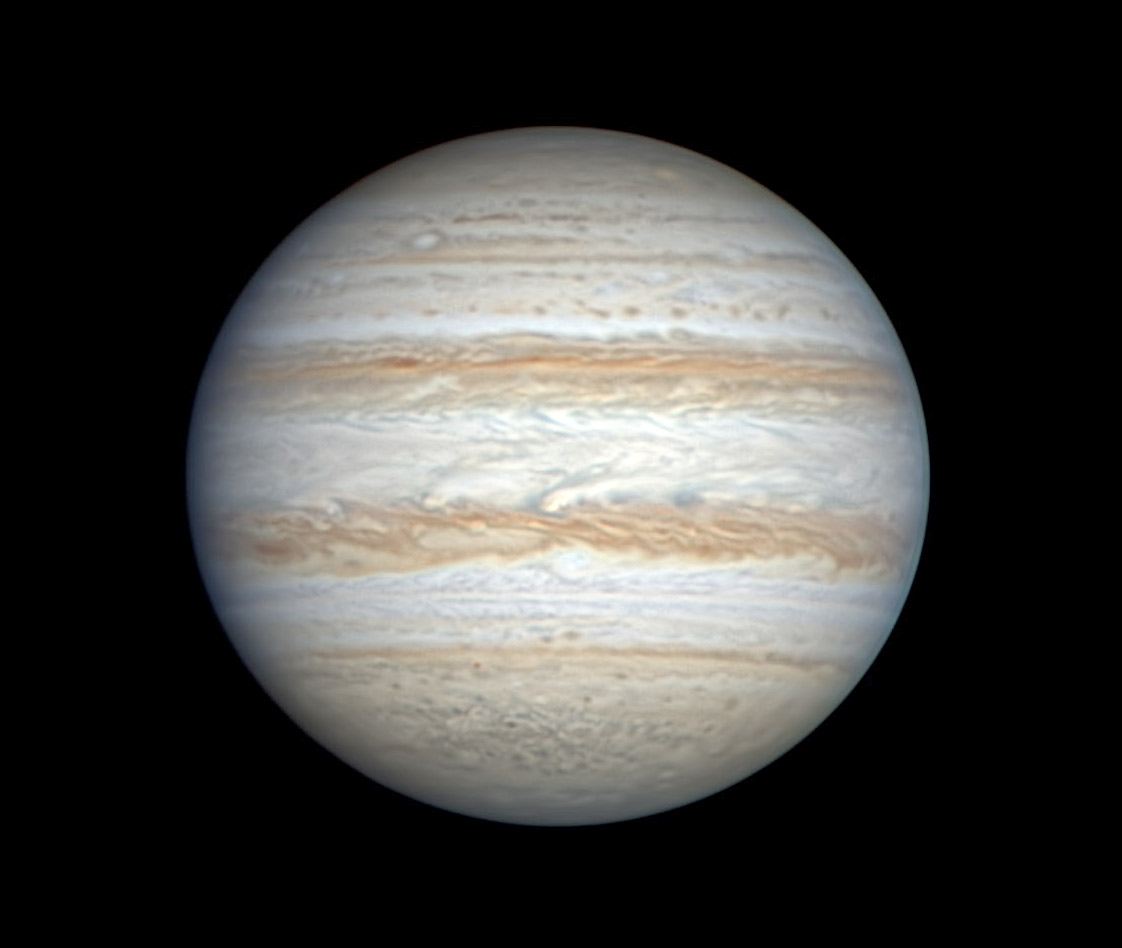
Saturn (magnitude +0.6, in dim Aquarius) is the brightest "star" in the southeast in twilight. It's three weeks past opposition. Saturn shines at a good height for telescopic observing by about 9 p.m., while Fomalhaut twinkles two fists at arm's length below it. Saturn stands highest in the south around 11.
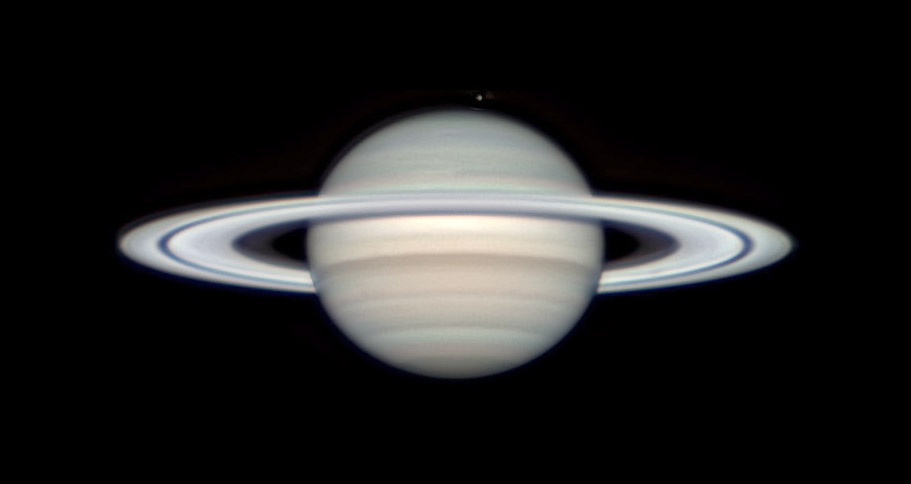
Uranus, magnitude 5.7 in Aries, is 8° east of Jupiter.
Neptune, magnitude 7.8 at the Aquarius-Pisces border, is nice and high by mid-evening 24° east of Saturn.
All descriptions that relate to your horizon — including the words up, down, right, and left — are written for the world's mid-northern latitudes. Descriptions and graphics that also depend on longitude (mainly Moon positions) are for North America.
Eastern Daylight Time (EDT) is Universal Time minus 4 hours. UT is also known as UTC, GMT, or Z time.
Want to become a better astronomer? Learn your way around the constellations. They're the key to locating everything fainter and deeper to hunt with binoculars or a telescope.
This is an outdoor nature hobby. For a more detailed constellation guide covering the whole evening sky, use the big monthly map in the center of each issue of Sky & Telescope, the essential magazine of astronomy.
Once you get a telescope, to put it to good use you'll need a much more detailed, large-scale sky atlas (set of charts). The basic standard is the Pocket Sky Atlas (in either the original or Jumbo Edition), which shows all stars to magnitude 7.6.

Next up is the larger and deeper Sky Atlas 2000.0, plotting stars to magnitude 8.5; nearly three times as many. The next up, once you know your way around, are the even larger Interstellarum atlas (stars to magnitude 9.5) or Uranometria 2000.0 (stars to mag 9.75). And be sure to read How to Use a Star Chart with a Telescope. It applies just as much to charts on your phone or tablet as to charts on paper.
You'll also want a good deep-sky guidebook. A beloved old classic is the three-volume Burnham's Celestial Handbook. An impressive more modern one is the big Night Sky Observer's Guide set (2+ volumes) by Kepple and Sanner.
Do computerized telescopes replace charts? Not for beginners I don't think, especially not on mounts and tripods that are less than top-quality mechanically. Unless, that is, you prefer spending your time getting finicky technology to work rather than getting to know the sky. And as Terence Dickinson and Alan Dyer say in their Backyard Astronomer's Guide, "A full appreciation of the universe cannot come without developing the skills to find things in the sky and understanding how the sky works. This knowledge comes only by spending time under the stars with star maps in hand."
But finding faint objects the old-fashioned way with charts isn't simple either. Learn the tricks at How to Use a Star Chart with a Telescope.
![]() Audio sky tour. Out under the evening sky with your
Audio sky tour. Out under the evening sky with your
earbuds in place, listen to Kelly Beatty's monthly
podcast tour of the naked-eye heavens above. It's free.
"The dangers of not thinking clearly are much greater now than ever before. It's not that there's something new in our way of thinking, it's that credulous and confused thinking can be much more lethal in ways it was never before."
— Carl Sagan, 1996
"Facts are stubborn things."
— John Adams, 1770
 8
8









Comments
mary beth
September 22, 2023 at 10:29 am
Happy Autumn everyone! Hope we all have a crisp, clear week for the harvest moon viewing!
Also wanting Sagittarius to hurry to pour out those last drops of summer…our heat index yesterday was 107°! I’m ready for cider and sweaters but we are still sweating in Houston.
You must be logged in to post a comment.
mary beth
September 24, 2023 at 12:40 am
We are still enjoying Scorpius, the Cat’s Eyes very bright all evening just a little west of the meridian. A couple of stars in the tail seem especially bright.
Saturn and Fomalhaut are stealing the show in the later evening. I hope most people can see both. Fomalhaut is not so lonely this year! Jupiter is magnificent very late evening.
You must be logged in to post a comment.
Rod
September 25, 2023 at 7:34 am
Very good mary beth. I had Ophelia move through this weekend and still dealing with clouds and some light rain at times, all the way to the end of this week 🙂 Briefly this morning near 0545 EDT, I could see some open sky above. Bright Venus, Orion, and Jupiter. However, only briefly, now more clouds 🙂
You must be logged in to post a comment.
New Jersey Eclipse Fan
September 26, 2023 at 11:09 am
Great reading your posts (especially Mary Beth's)! Later this week the wife & I are headed to Israel for the pilgrimage festival of Sukkot--the Feast of Tabernacles--which begins simultaneously with Shabbat--the Sabbath--at sundown Friday. This will complete the "trifecta," with the others being Shavuot--the Feast of Weeks or Jewish Pentecost (June 2022) and Pesach--Passover or the Feast of Unleavened Bread (April 2023). The rainy season is over in the Holy Land--unlike the recent weather here (I hear you, Rod!)--so I'm looking forward to some exciting sky-gazing. Oh, and it doesn't hurt to be able to see our three grandchildren together in person for the first time in over five months!
You must be logged in to post a comment.
mary beth
September 27, 2023 at 10:53 am
Good morning NJEF! So great seeing you here! Very happy to hear you have such wonderful plans and I am praying for safe travels for you and your wife. I’ve been thinking about you both because I know September is such a special month for our Jewish brethren! Hope you have a wonderful time of fellowship and feasting! Try to update us if you can next week! Happy Ingathering!
You must be logged in to post a comment.
mary beth
September 27, 2023 at 10:57 am
Just read this on Chabad.org:
On the Jewish holiday of Sukkot we build a temporary hut, called a “sukkah,” and cover it with detached branches or greenery. This covering is called sechach.
…. the Jerusalem Talmud2 adds that ideally one should not place too many branches on top of the sukkah, so that one can still see the larger stars in the night sky through them.
Rabbi Joseph Teomim (d. 1792) explains that gazing at the heavens and seeing the stars reminds one of the majesty and awesomeness of the Creator. This idea is articulated by King David (Psalms 8:4–5): “When I see Your heavens, the work of Your fingers, the moon and stars that You have established, what is man that You should remember him, and the son of man that You should be mindful of him?”
You must be logged in to post a comment.
New Jersey Eclipse Fan
September 27, 2023 at 12:15 pm
So sweet of you to go to those lengths to beautifully encapsulate what is our favorite extended Jewish holiday (the most fun one, Purim, lasts but a day)! Like Pesach (Passover), since Sukkot always begins on the evening of the 15th of the Jewish Lunar month (in this case, Tishrei), there is ALWAYS a full moon to guide us through the night. But don't get hung up on the September thing you mentioned above; due to the new Jewish year of 5784 being a leap year, Rosh Hashana 5785 begins the evening of October 2, 2024, so next September is nothing special!
You must be logged in to post a comment.
mary beth
September 27, 2023 at 12:49 pm
So very interesting! I’m going to look up the names and meanings of all the months on the Jewish calendar. What originally piqued my interest in this years ago is the Old Farmer’s Almanac. They have a lot of information on their calendar!
(On a sidenote, the Anglo-Saxon names things are great as well October being Winmonath!)
You must be logged in to post a comment.
You must be logged in to post a comment.